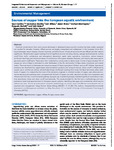Sources of copper into the European aquatic environment
| dc.contributor.author | Comber, Sean | |
| dc.contributor.author | Deviller, G | |
| dc.contributor.author | Wilson, I | |
| dc.contributor.author | Peters, A | |
| dc.contributor.author | Merrington, G | |
| dc.contributor.author | Borrelli, P | |
| dc.contributor.author | Baken, S | |
| dc.date.accessioned | 2022-12-05T11:01:46Z | |
| dc.date.available | 2022-12-05T11:01:46Z | |
| dc.date.issued | 2022-12-01 | |
| dc.identifier.issn | 1551-3777 | |
| dc.identifier.issn | 1551-3793 | |
| dc.identifier.uri | http://hdl.handle.net/10026.1/20048 | |
| dc.description.abstract |
Chemical contamination from point source discharges in developed (resource-rich) countries has been widely regulated and studied for decades; however, diffuse sources are largely unregulated and widespread. In the European Union (EU), large dischargers report releases of some chemicals, yet little is known of total emissions (point and diffuse) and their relative significance. We estimated copper loadings from all significant sources including industry, sewage treatment plants, surface runoff (from traffic, architecture, and atmospheric deposition), septic tanks, agriculture, mariculture, marine transport (antifoulant leaching), and natural processes. A combination of European datasets, literature, and industry data were used to generate export coefficients. These were then multiplied by activity rates to derive loads. A total of approximately 8 kt of copper per annum (ktpa) is estimated to enter freshwaters in the EU, and another 3.5 ktpa enters transitional and coastal waters. The main inputs to freshwater are natural processes (3.7 ktpa), agriculture (1.8 ktpa), and runoff (1.8 ktpa). Agricultural emissions are dominated by copper-based plant protection products and farmyard manure. Urban runoff is influenced by copper use in architecture and by vehicle brake linings. Antifoulant leaching from boats (3.2 ktpa) dominates saline water loads of copper. It is noteworthy that most of the emissions originate in a limited number of copper uses where environmental exposure and pathways exist, compared with the bulk of copper use within electrical and electronic equipment and infrastructure that has no environmental pathway during its use. A sensitivity analysis indicated significant uncertainty in data from abandoned mines and urban runoff load estimates. This study provided for the first time a methodology and comprehensive metal load apportionment to European aquatic systems, identifying data gaps and uncertainties, which may be refined over time. Source apportionments using this methodology can inform more cost-effective environmental risk assessment and management. | |
| dc.format.extent | 1031-1047 | |
| dc.format.medium | Print-Electronic | |
| dc.language | en | |
| dc.language.iso | eng | |
| dc.publisher | Wiley | |
| dc.subject | Apportionment | |
| dc.subject | Europe | |
| dc.subject | copper | |
| dc.subject | diffuse | |
| dc.subject | source | |
| dc.subject | water | |
| dc.subject | Copper | |
| dc.subject | Environmental Monitoring | |
| dc.subject | Environmental Exposure | |
| dc.subject | Agriculture | |
| dc.subject | European Union | |
| dc.subject | Risk Assessment | |
| dc.title | Sources of copper into the European aquatic environment | |
| dc.type | journal-article | |
| dc.type | Journal Article | |
| plymouth.author-url | https://www.ncbi.nlm.nih.gov/pubmed/36239378 | |
| plymouth.issue | 4 | |
| plymouth.volume | 19 | |
| plymouth.publication-status | Published | |
| plymouth.journal | Integrated Environmental Assessment and Management | |
| dc.identifier.doi | 10.1002/ieam.4700 | |
| plymouth.organisational-group | /Plymouth | |
| plymouth.organisational-group | /Plymouth/Faculty of Science and Engineering | |
| plymouth.organisational-group | /Plymouth/Faculty of Science and Engineering/School of Geography, Earth and Environmental Sciences | |
| plymouth.organisational-group | /Plymouth/REF 2021 Researchers by UoA | |
| plymouth.organisational-group | /Plymouth/REF 2021 Researchers by UoA/UoA06 Agriculture, Veterinary and Food Science | |
| plymouth.organisational-group | /Plymouth/Research Groups | |
| plymouth.organisational-group | /Plymouth/Research Groups/BEACh | |
| plymouth.organisational-group | /Plymouth/Research Groups/Marine Institute | |
| plymouth.organisational-group | /Plymouth/Users by role | |
| plymouth.organisational-group | /Plymouth/Users by role/Academics | |
| dc.publisher.place | United States | |
| dcterms.dateAccepted | 2022-10-10 | |
| dc.rights.embargodate | 2022-12-6 | |
| dc.identifier.eissn | 1551-3793 | |
| dc.rights.embargoperiod | Not known | |
| rioxxterms.versionofrecord | 10.1002/ieam.4700 | |
| rioxxterms.licenseref.uri | http://www.rioxx.net/licenses/all-rights-reserved | |
| rioxxterms.type | Journal Article/Review |


